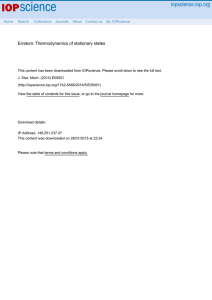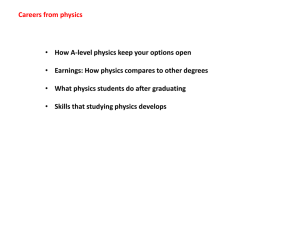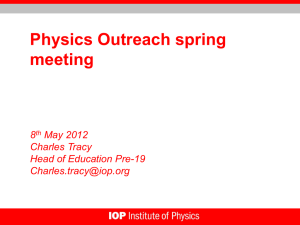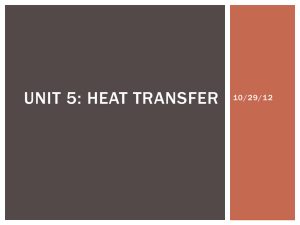Presentation
advertisement
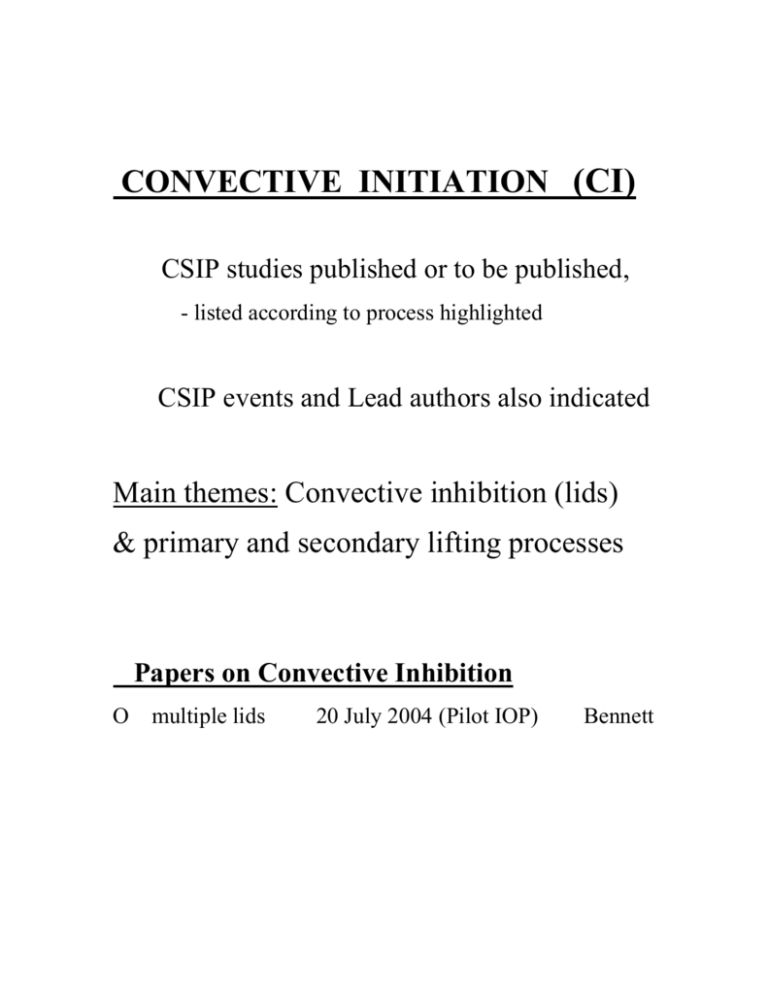
CONVECTIVE INITIATION (CI) CSIP studies published or to be published, - listed according to process highlighted CSIP events and Lead authors also indicated Main themes: Convective inhibition (lids) & primary and secondary lifting processes Papers on Convective Inhibition O multiple lids 20 July 2004 (Pilot IOP) Bennett Papers on Primary Initiation processes Upper-level forcing O u/l PV anomaly 15 June 2005 (IOP 1) Russell 18 July 2005 (IOP 9) Russell O shading by anvils 29 June 2005 (IOP 5) Marsham Low-level forcing (non-topographical) O boundary-layer rolls 28 July 05 (IOP 12) Marsham Low-level forcing (by topography) O line downwind of coastal promontory 15 June 2005 (IOP 1) Morcrette 4 July 2005 (IOP 6) (White) O sea breeze 13 July 2005 (IOP 8) Blyth/Bennett) O hills 15 June 2005 (IOP 1) Lean 18 Aug 2005 (IOP 16) (Morcrette) Papers on Secondary Initiation (& maintenance) processes O density current 25 Aug 2005 (IOP 18) O gravity wave 10 July 2004 (Pilot) Clark (i) Morcrette (ii) Marsham 24 June 2005 (IOP 3) (i) (Browning) (ii) (Marsham) CIN Bennett (Pilot IOP) - Stable layers (lids) play key role in controlling CI - Case study shows multiple lids (5) with continuity over hours - Individual layers delayed vertical development of convection - Development of convection up to LCL explained best by assuming T and RH for parcels based on surface-layer averages - Development of convection above LCL explained best by assuming 950-1000 mb average values for parcels - Important to predict altitude, strength and persistence of lids in order to forecast intensity, location and timing of CI - Also important to predict mesoscale regions of lifting to pinpoint where lids will be broken Primary CI Russell (IOPs 1 & 9) - Upper-level PV maxima associated with lowered tropopause play 2 key roles in development of deep convection: (1) a moving u/l PV-max distorts isentropic surfaces so as to reduce static stability beneath it (2) filaments of high PV (tropopause folds) descend into the lower troposphere where they act as lids Together these 2 processes increase both CAPE and CIN, thereby favouring more intense convection Marsham (IOP 5) - Case study of CI in presence of shadowing from high-level cirrus canopies due to decayed convective storms - Ci usually occurred in gaps between cirrus canopies, even though gaps were small (50 km) and moving rapidly (15 m/s) - LEM simulations confirmed that extra heating of BL beneath moving gaps, plus convergence effects beneath canopy boundary, could trigger convection - Subsidence warming and drying found in BL beneath cirrus canopies - In the absence of stronger forcing, such weak forcings can determine location and timing of CI - Difficulty in forecasting/assimilating orphaned anvils limits predictability of CI in these circumstances Marsham (IOP 12) - Observational study of BL convective rolls/ cloud streets orientated along direction of strong southerly winds after crossing south coast of England - As depth of BL rolls increased from 2 to 4 km, spacing of rolls jumped from 6 to 12 km and initially light showers developed - After a further ~1 hour, the capping inversion/lid was penetrated, and convection reached 9 km to form lines of thunderstorms - LEM simulations reproduce the doubling in roll spacing but need to investigate dynamics of doubling - Also need to investigate whether linear arrangement of rolls affects entrainment/mixing and hence the subsequent deepening of convection Morcrette (IOP 1) - Topographically-forced convergence line observed extending downwind from South-west Peninsula of England - BL was capped at 2 km except along convergence line where depth increased to 3 or 4 km; - this was observed by mapping the BL capping inversion (lid) using clear-air radar, and was also reproduced by the 1.5-km grid UM - Convection along line gave mainly shallow light rain showers. Additional mesoscale lifting provided by u/l PV max enabled convection to penetrate lid in one place to form single thunderstorm - High-resolution NWP models are good at forecasting topographically-forced BL convergence lines (and did on this occasion) but also need to represent presence and effect of u/l PV max (and did). Lean (IOP 1) - Model simulations showed that the convergence line downwind of the South-west Peninsula started as coastal convergence driven by land-sea roughness contrast, but the convergence was enhanced by hills (Dartmoor) - Initiation of deeper convection occurred 30 km downstream of Dartmoor and was not due to the direct effects of lifting or elevated heating - Instead, the key role of Dartmoor was for the descent in the lee to lead to a local cloud clearance which then led to additional heat and moisture fluxes - These subtle effects were well represented by the 1.5-km grid UM Morcrette (IOP 16) - A case of isolated convective showers breaking out in light-wind conditions - Hoped to find showers associated with ADC (Area of Deeper boundary-layer Convection) formed directly over hills (as found over Cotswold hills in 1970 study) - But no clear ADC effect found in this or any other CSIP case Secondary CI Clark (IOP 18) - Case study of an MCS associated with combination of upright convection and slantwise updraught and downdraught or rear-inflow jet (RIJ) - Diabatic cooling from microphysics generates surface cold pool causing system to propagate faster - Cold-pool propagation well forecast by 1.5-km UM - But generation of new secondary convective lines sensitive to interplay between a number of microphysical processes: (i) warm-rain production and cooling by rain evaporation forces near-surface jet at gust front (ii) cooling by melting snow forces jet behind and slightly higher (iii) cooling by ice and snow sublimation forces the RIJ much farther behind and higher up Each of these processes has different time scale, making it difficult for quasi-steady state propagation to occur Morcrette (Pilot IOP) - Convective lines triggered ahead of storm by gravity waves - Triggering occurred well in advance of any surface cold pool/density current - Wave-like modulation in depth of BL observed long before new convection triggered: Horizontal wavelength ~40-50 km Amplitude +/- 150 m, enough to overcome weak CIN - Velocity of wave train comparable with velocity of resulting convective clouds, thereby reinforcing their continued development rather than triggering convection elsewhere Marsham (Pilot IOP) - Modelled storm generates gravity waves, two modes of which triggered the observed lines - Amplitude of modelled wave was largest downwind of primary storm and initiated convection there only - A non-hydrostatic high-resolution (~1-km) NWP model should be able to capture such wave processes Browning (IOP 3) - Many MCSs are associated with elevated convection (not predicted well) - Case study shows elevated convection with upright convection plus dual slantwise circulations (possible causes?); the lower slantwise downdraught was the main rear-inflow jet (RIJ) - Slope of RIJ decreased with time - RIJ did not penetrate to ground through cold undercurrent; instead it compressed the undercurrent where it impacted, and the undercurrent deepened ahead of it to form gravity wave - Shear strengthened where the RIJ impacted undercurrent, leading to KH billows (?) and mixing - Does failure of RIJ to penetrate to ground and generate density current lead to a weaker storm, or is gravity wave just as effective in forcing convection? - What is relative importance of impact of RIJ and evaporative cooling in the undercurrent to the generation of the undercurrent gravity wave? - Does the evaporative cooling of rain help to prevent the RIJ from penetrating the undercurrent? Marsham (IOP 3) Observed properties of undercurrent gravity wave: - it moved with the MCS - it was quasi-steady state for >2 hours - sfc pressure anomaly +2 mb over 25 km - associated with a ground-relative wind reversal up to 1000 m deep - lifting of streamlines by up to 1000 m - rain evaporation giving <1C cooling and 0.5 g/kg moistening Extended region of cooling (~4C) caused by shadowing from anvil canopy Decrease in static stability with height and opposing low-level flow in undercurrent leads to trapping/ducting, which increases amplitude of undercurrent wave and hence increases lifting to overcome CIN of source air for updraught Possible generation mechanisms for undercurrent gravity wave: (i) impact of RIJ on undercurrent (ii) latent heat release in convection (iii) evaporation cooling in undercurrent


